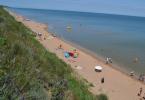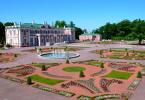All about Giant's Trail Northern Ireland, 100 km from Belfast. How to get there and what to see. The history of the appearance of hexagonal pillars.
There is no more popular attraction in the North than the Road of the Giants. This phenomenon wants to see all the tourists who arrived in these parts.
True, "The Road of the Giants" (eng. Giant's Causeway, other names - "The Bridge of the Giants", "The Path of the Giants") - just a poetic name inherited from ancient legend. The mythical giants are not involved in her creation and have never moved along huge boulders. However, about 40,000 basalt pillars, vertically sunk into the ground, are carefully fitted to each other. And they give the impression of a man-made object. So what is the Path of the Giants?
Beginning of the Causeway of the Giants (Antrim Plateau, Northern Ireland)
The stone massif descends into the sea from a steep bank in tiers. Pillars-columns form at the same time stone steps, unevenly spaced. So, as if time and sea waves have aged their previously beautiful view. In profile, most of the columns are hexagonal in shape. This geometry allows individual elements closer contact with each other.
Occasionally on the Giant's Road there are pillars with five to eight faces. The length of the highest pillars-columns can reach 12 meters or more.
How to get to the Bridge of the Giants?
Giant's Road is located in Northern Ireland, 3 kilometers from small town Bushmills. You can also get there by tourist bus from Belfast - a distance of about 100 km. Group tours with a visit to the Trail and all locations related to the Game of Thrones series, cost around 60 € per person.
For independent travelers an interesting option: to get from Belfast to Bushmills. And from there on the steam railway to Giant's Trail.
- By bus. From stop War Memorial flight No. 172, 402, 402a departs. Buses run every 30-40 minutes. Before Giants Causeway The Nook where you need to get off, only three stops. From there, you will have to walk another 30 minutes to the visible part of the Giant's Road, along the coast.
- On an old train. The most romantic way to get to Giant's Trail is to take the diesel train to Bushmills platform. Six times a day, from 11:00 to 16:30, he delivers tourists to a popular attraction. The train takes longer than the bus - about 15 minutes. But the views along the way are fabulous, and the kids are delighted with the trip. More details on the website.
Ride the Bushmills Railway Tram-train from Bushmills to Giant's Causeway:
On the official website www.translink.co.uk you can see the schedule of buses and trains (from Belfast to Bushmills, for example). And check ticket prices.
Excursions in the UK
Most interesting excursions- these are routes from local residents to Tripster. It's better to start with (see iconic places British capital, outline walking routes). Then go for the whole day to. For 8 hours of excursion with a transfer, you will have the opportunity to walk around the city and see the dances of stone giants.
Versions about the origin of the Road of the Giants
For those who need to prepare for the trip and learn everything about the object of interest, we have two versions of the origin of the Giant's Trail.
1. Legend of MacQuil and Fingal
According to one of the existing myths, the giant road was built by a giant who lived in these places, who bore the name Mac Kuil. Wanting to get by sea to the coast of Scotland, he installed countless basalt pillars on the seabed, building his own way. In Scotland Mac Cuil had to fight his enemy Fingal.
When the work was finished, McQuil decided to rest by sleeping on the seashore. At this time, Fingal crept up to the giant, making his way to Ireland along the stone columns. However, Mac Kuil's wife noticed the enemy in time and decided to scare him. She called out to Fingal that the sleeping giant was her child. But soon the husband will return to send the uninvited guest out. Fingal was not a little surprised by the size of the baby, and, imagining Mack Kuil, decided not to tempt fate.

Hike the Giant's Causeway in Ireland
Withdrawing, he fled to Scotland along the Giant's Road. True, destroying it on the go in order to avoid the persecution of the father of the family. Those fragments of the road that have survived to this day can be seen today on the Antrim Plateau.
2. Scientific explanation
Scientists who study the phenomenon of the Giant's Road have a different opinion. In ancient times, when terrestrial landscapes were just being formed, in these places arose a large number of large volcanoes spewing liquid hot lava, consisting of basalt. The molten lava flowed down the hills towards the sea at a speed of 50 km/h. At the same time, she could cover decent distances.
As a result, the basalt deposits crystallized and cracked from the cold, forming hexagonal column-like structures.
Tourists who do not agree with the opinion of Northern Ireland scientists are invited to personally arrive at the location of the surviving fragments of the Giant's Road. And feel the elements of this natural creation with your own hands. Perhaps someone will come up with a more convincing version than those known so far.
Hotels in Bridge of the Giants
You can drive from Belfast to Bushmills and walk along the Giant's Trail in one day. Buses and trains run frequently. In extreme cases, you can leave by night train. But that doesn't stop romantics from wanting to spend the night overlooking the inhospitable Irish cliffs. The place is fascinating, there is where to take a walk in the surroundings.
So the large number of hotels on the outskirts of Bushmills is no surprise. By the way, and the prices by British standards there are quite adequate.
The Bridge of the Giants is located 100 km from Belfast (the capital of Northern Ireland). And 3 km from the town of Bushmills.Once again, nature is showing us one of its phenomenal tricks. On the coast of the northern part of Northern Ireland (forgive the tautology, but that's the way it is) is the Giant's Causeway. This unique phenomenon of nature looks like unusual pillars, the section of which is very similar to a honeycomb.
The pillars (or columns) are so tightly pressed against each other that even a knife cannot be stuck between them. Approximately the same fit large stones in the walls ancient city Sacsayhuaman, with the only difference being that people did it there, and nature here.
Road of the Giants on the map
- Geographic coordinates 55.240684, -6.511417
- The distance from the capital of Northern Ireland, the city of Belfast, is approximately 80 km.
- Distance to the nearest airport Derry about 50 km
It should be noted that Northern Ireland is an administrative part of the UK, and not a separate state.
The Giant's Road is located 3 kilometers north of the town of Bushmills.
This attraction has about 40,000 basalt columns interconnected. Most of the pillars are hexagonal, but there are also four, five, seven and octagonal specimens. Their height reaches 12 meters. The diameter of the pillars is from 30 to 50 cm.

Considering this unusual natural structure, it is hard to believe that it appeared by chance. By official version scientists, such extraordinary columns arose after a volcanic eruption in antiquity. Active volcanic phenomena took place here 50-60 million years ago. Molten basalt flows formed huge lava fields. With rapid cooling, the volume of the substance was reduced, and horizontal compression contributed to the appearance of such geometrically regular structures.
There is another hypothesis according to which the Road of the Giants was formed as a result of convection of a viscous substance under conditions of cooling of the upper layers.
Local residents, of course, associate the appearance of this structure with an ancient legend.
It says that the hero of the Celtic myths, warrior, sage and seer Finn McKumal decided to measure his strength with a huge one-eyed monster named Goll, who lived in Scotland. But by some absurd accident or random absurdity, the heroic hero… was afraid to get his feet wet. Finn had to drive a whole lot of columns into the bottom of the sea - it turned out to be a kind of bridge on neighboring island. He was very tired and decided to sleep before the battle. While our hero was peacefully dreaming, Goll, without waiting for his opponent, himself came to visit him along the already built bridge. He was met by Uma, Finn's wife. Judging by the name, the lady was not stupid. She cheated a little: pointing to her sleeping husband, she said that he was her child. As you understand, this comrade did not at all resemble a child in size. Uma sat the giant at the table and began to treat him with cakes, in which she had previously baked iron pans. Other cakes (already without pans inside) she set aside for her husband. When Goll began to break his teeth, eating his treat, the awakened Finn calmly ate his cakes "on both cheeks." Realizing that if the baby is like that !!!, then his dad will be completely invincible, Goll runs away in a panic and destroys the bridge along the way, cutting off the path for persecution.
Whether the Road of the Giants appeared as it is said in myth or as scientists suggest is no longer so important. The main thing is that now we have one more unsolved and therefore very attractive natural attraction.

The Road of the Giants runs for more than 270 meters along the coast and about 150 meters along the bottom of the sea. All columns are very hard and have a dark color. This is due to the high content of magnesium and iron in their composition. Such a mixture of substances is practically not subject to the destructive action of sea waves and wind.
Near the Giant's Road there are cliffs with original names. Harp Rock - its columns are curved and descend to the shore. The cliff of the Organ, whose pillars are straight and very similar to this huge musical instrument.
There are also cliffs Giant's Loom, Coffin and Giant's Eyes. Here you can still see the Giant's Shoe. This is a huge cobblestone in the form of shoes and 2 meters high.

- in 1986, UNESCO declared the Giant's Causeway and the Causeway Coast, where it is located, a World Heritage Site, and only a year later, the Department of Environmental Protection awarded this place the status of a National Wildlife Refuge
- despite the fact that the Road of the Giants has been here for thousands, and possibly millions of years, it was widely known only in the 17th century from the stories of the Bishop of Derry. And only at the beginning of the 19th century the first tourists came here.
- access for tourists here is nowhere and is not limited in any way
- in Scotland, on the island of Staffa, there is a unique one, the walls of which (like the coast of the island itself) consist of the same hexagonal basalt columns. Perhaps this is also part of the Road of the Giants
Road of the Giants photo






Giant's Road is an impressive rock formation on the Antrim coast of Northern Ireland. The site consists of about 40,000 basalt columns rising from the sea. The road of giants is the only object world heritage UNESCO in Northern Ireland.
An unusual formation arose as a result of natural processes during the Paleogene (65-23 million years ago), when Northern Ireland was subjected to powerful volcanic activity. During this period, molten basalt was in contact with the Cretaceous layers, forming a lava plateau. As the lava cooled quickly, the plateau shrank and cracked, forming 40,000 hexagonal columns of various heights that look like giant steps. The height of the largest of them is almost 11 meters.

Legend
Popular mythology attributes the creation of the dam to an Irish giant named Fionn mac Cumhaill (or Finn MacCool). To prove his superior strength and status, Fionn decided to take on a rival, a Scottish giant named Benandonner. Since there was no boat big enough to take the huge Finn across the sea to confront Bennandonner, he built his own step ladder from Ireland to Scotland.

However, when he crossed the sea, he saw how great Bennandonner was. He ran back to Ireland before Bennandonner saw him, but the causeway was built and Bennandonner came to fight. Fionn climbed into the crib, and when Bennandonner came to the door to fight him, his wife told him not to wake the baby. Seeing how big "baby" Fiona was, Bennandonner got scared and ran back to Scotland.

Although the phenomenon of basalt columns is relatively rare, there are several such examples of rock formations found throughout the world, including in Scotland, Los Prismas Basalticos in Mexico, and Devil's Postpile in California.

Address: Northern Ireland, 3 km from Bushmills
Coordinates: 55°14"25.3"N 6°30"40.3"W
Short description
The village of Bushmills, located in County Antrim in Northern Ireland, is known for two attractions. This is "Old Bushmills" - the oldest whiskey distillery in Europe and a natural phenomenon called "The Giants' Road", or "The Giants' Trail".
From a distance, the “giant road” looks like an ordinary rocky stretch of coast, but when you get closer, you can see how tens of thousands of blocks, arches and columns go down into the depths of the sea, resembling a giant path. A few centuries ago, scientific discussions about the origin of the Giant's Road did not subside.
Some researchers claimed that the Giant's Path is a huge crystals born at the bottom ancient sea, and opponents objected to them: “No, here the surf exposed the petrified bamboo forest". Today scientific world came to a consensus: in the territory of County Antrim there was the largest lava plain in Europe.

Its basis was basalt erupting from the mouth of an ancient volcano. The molten basalt hardened and cracked, forming regular hexagonal prisms. Together, these prisms create an amazing pattern that vaguely resembles a honeycomb. The road of giants has 40 thousand basalt structures. Stone columns fit so tightly to each other that one might think that they were driven into the ground by an ancient hero. The dark color of the columns and their exceptional hardness are due to the fact that they are composed of basalt with a low concentration of quartz, but rich in magnesium and iron. This reduces the rate of their destruction due to the impact of the rough waters of the Atlantic.

Road of the Giants in Celtic Myths
Even in the III century. n. e. the Celts sang the Road of the Giants in legends. In ancient times, a giant named Finn Mac Cumal lived in Ireland. Opposite him, across the strait, the one-eyed evil son of the gods, Goll Mac Morna, settled.
Finn decided to fight his enemy neighbor, but he couldn't swim and started building a bridge. For 7 days and 7 nights, Finn did not close his eyes, dragged huge stone rods, and in the end got tired and went home to sleep. In the meantime, Goll crossed the bridge to Ireland and came to Finn.

Finn's wife was not at a loss: she swaddled her husband like a baby and lied to Goll that this was her sleeping son. In addition, the woman treated Goll with pancakes, inside which she baked flat frying pans. The enemy broke their teeth on them. And the second cake, a simple wife, gave to the “baby”, and he ate it with appetite. “If a child is so huge and so easily bites through pancakes that I break my teeth on,” Gall thought, “then how strong must his father be?” Seriously frightened, Goll rushed to run, breaking the entire bridge behind him.

Road of the Giants - geological wonders in stone
In addition to the Path of the Giants, on the same plateau you can see the "Organ of the Giants". It consists of 60 high straight columns resembling the pipes of a huge organ - musical instrument. Another attraction of the Giant's Road - "Smokestacks" - is associated with the Spanish "Invincible Armada". Under the influence of waves and wind, pillars of an unusual shape formed on the basalt cliff. From the sea they can be mistaken for the chimneys of a huge castle.

The legend says: in 1588, the Spaniards from the ship "La Girona", fleeing after the defeat of the "Armada", began to fire at the cliff, deciding that in front of them was the enemy's castle. The ship "La Girona" crashed on the rocks, taking with it 1300 human lives. Treasures of "La Girona", raised from seabed are kept at the Ulster Museum in Belfast.
The Giant's Causeway in Northern Ireland is a unique natural phenomenon: interconnected basalt hexagonal columns create amazing landscapes that resemble a natural pavement. The path is the result of the activity of an ancient volcano; ledges were formed when a lava flow cooled. trails: the road was built by the hero of the Celtic myths Finn McKumal.
The pavement of giants really could serve as a road: columns of different heights (from 6 to 12 meters) seem like a ladder, and cracks are the result of a sloppy layout of a nature trail.
In 1986, the Bridge of the Giants was inscribed on the UNESCO World Heritage List.
To visit the Path of the Giants, you should choose comfortable clothes and shoes, best of all - with rubber soles.
It is better to plan a trip to the Bridge of Giants for the period from late spring to autumn. There are no tours of the Giant's Path during winter. Be careful: the weather in the north of Ireland is quite changeable. In strong winds and rain, approaching a cliff can be dangerous.
Tourist office where you can get detailed information about the Causeway of the Giants and buy souvenirs, located at 44 Causeway Road. When buying a ticket, tourists receive an audio guide in Russian (English, French, German, Spanish, Italian, Polish, Japanese and Mandarin are also available).
How to get there
The bridge of the giants is located in the north-east of Northern Ireland, 100 km from Belfast. Bus service connects Giant's Trail and Belfast: tour buses run (mainly in summer time), can also be reached by bus 252, which runs along the picturesque coast of Antrim.
From the end of spring to the beginning of autumn, you can get to the Bridge of the Giants by tourist buses from Bushmills, as well as from another attraction of Northern Ireland -. In summer, minibuses also run from the Tourist Office.
From Belfast and Londonderry you can also take the Translink trains (www.translink.co.uk). Closest to the Bridge of the Giants railway stations- Portrush (Portrush) and Coleraine (Coleraine), from where regular buses follow to the coast.
Steam Railway connects Bushmills and Giant's Trail; the station is located 200 meters from the main entrance to the natural park.
Travel time from Belfast by car is about an hour and a half. Follow the M2 to the junction with the A26. Turning right, follow until the turn onto the M2. After passing the town of Ballymena, continue on the A26 to the town of Ballymoney. Turning right, follow Ballybogy Road to the junction with Priestland Road. Turn right again and continue to Causeway Road.
Location
The Causeway of the Giants is located in County Antrim at .




